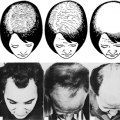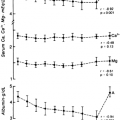SYSTEMIC HORMONES THAT AFFECT BONE METABOLISM
Part of “CHAPTER 50 – PHYSIOLOGY OF BONE“
Many hormones that regulate somatic growth act directly or indirectly on the skeleton. These hormones not only modulate physiologic skeletal growth and development but also are important in the pathogenesis of metabolic bone disease.
GLUCOCORTICOIDS
Glucocorticoids have complex direct and indirect effects on skeletal tissue. The major indirect effect is the inhibition of calcium absorption in the intestine. This may lead to secondary hyperparathyroidism, which could explain the clinical observation that bone resorption is increased in some patients treated with glucocorticoids. Nevertheless, the major direct effect on bone is a dose-related decrease in formation.49 This is probably mediated by a decrease in the replication and differentiation of osteoblast precursors. However, glucocorticoids can also have a positive effect on osteoblast function. In some cell and organ cultures, physiologic concentrations of glucocorticoids can increase collagen synthesis, increase alkaline phosphatase levels,
and enhance the response to other hormones. These effects may be due to an increase in osteoblast differentiation.14
and enhance the response to other hormones. These effects may be due to an increase in osteoblast differentiation.14
Glucocorticoids can have both stimulatory and inhibitory effects on bone resorption. Stimulation may be due to enhanced osteoclast differentiation as well as secondary hyperparathyroidism. Inhibition of resorption may be due to decreased replication of osteoclast precursors or decreased production of bone-resorbing factors by osteoblasts, such as prostaglandins and interleukins. Whatever the mechanisms, hypercalcemia has been observed in adrenal insufficiency, and decreased bone mass is an important adverse effect of glucocorticoid excess (see Chap. 59 and Chap. 64).
GROWTH HORMONE AND INSULIN-LIKE GROWTH FACTORS
Excesses and deficiencies of growth hormone are associated with increases and decreases in skeletal growth. This effect is probably mediated by IGF-I (see Chap. 12 and Chap. 173).50 A major source of IGF is the liver, but many other tissues, including skeletal tissue, can produce IGF-I and also IGF-II, which is not under growth hormone control. Moreover, growth hormone can stimulate IGF-I production by bone cells. IGF-I and IGF-II have pleiotropic effects, stimulating bone cell replication as well as collagen and noncollagen protein synthesis. The relative importance of IGF-I and IGF-II in regulating bone growth and in metabolic bone disease is uncertain. Possibly, the decrease in bone mass seen in malnutrition and gastrointestinal disorders is related to decreased production of these factors. An age-related decrease in growth hormone and IGF-I secretion may play a role in bone loss. Bone tissue produces not only IGF-I and IGF-II but also a number of IGF-binding proteins that can be both inhibitory and stimulatory. The regulation of these binding proteins may be as important as the regulation of IGFs themselves in the local control of bone formation.51
INSULIN
Insulin is an important regulator of somatic growth. At physiologic concentrations, insulin appears to stimulate osteoblast function, selectively increasing collagen synthesis without affecting cell replication or protein synthesis in the periosteum.14 At higher concentrations, insulin can produce a pleiotropic effect, perhaps by acting on the IGF-I receptor. Insulin may be important in skeletal development. Bone mass may be increased by hyperinsulinism in the infants of diabetic mothers and decreased in diabetic children with insulin deficiency.
THYROID HORMONES
Thyroid hormones (thyroxine and triiodothyronine) are essential for maintaining skeletal growth and remodeling. They not only increase cartilage growth directly but also probably have a positive interaction with IGF-I. Thyroid hormones can increase bone turnover, an effect apparently due to direct stimulation of both bone resorption and formation.52,53a Decreased bone mass has been observed in hyperthyroid patients, including those who received large doses of exogenous thyroid hormones for long periods.53






